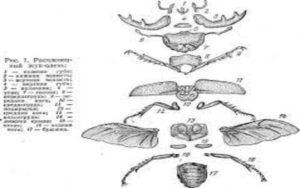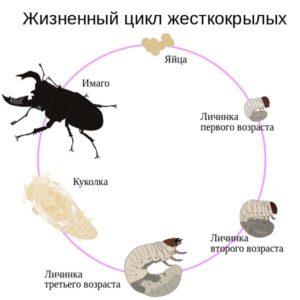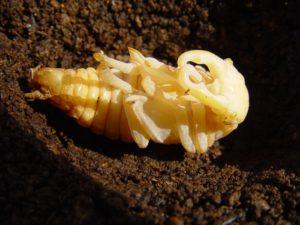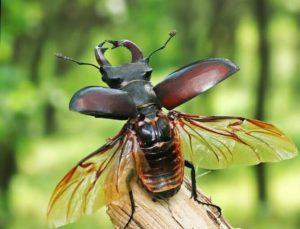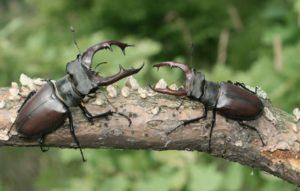Stag beetle: photo of a deer and its features of the largest beetle
The world of insects is very diverse and its most striking representatives are beetles. Some of them are able to completely merge with the environment, while others are painted in such bright colors that it is very difficult not to notice them. But, one of the representatives of the Coleoptera detachment, managed to stand out even from such a “motley” crowd. These beetles are very difficult to confuse with anyone, and people gave them a name - stags.
Content
What does a stag beetle look like
Who is the stag beetle
Name: stag beetle
Latin: lucanus cervusClass: Insects - Insecta
Squad: Coleoptera - Coleoptera
Family: Stags - Lucanidae
 | Habitats: | widespread |
 | Dangerous for: | does no harm |
 | Means of destruction: | needs protection |
Stag beetles are called stag beetles from the comb-beetle or stag beetle family. A characteristic feature of these insects is the hypertrophied mandibles in males, which outwardly very much resemble deer antlers. At the same time, in females, this part of the body is much less developed.
The largest representatives of the stag family can reach 9-11,5 cm in length, taking into account the "horns". Depending on the species, the color of the body of deer beetles acquires the following shades:
- black;
- brown;
- brown;
- Orange;
- golden;
- green.
The antennae of the stags are thin, long, with a comb-shaped club at the end. On the sides of the head are two complex compound eyes, and in the center there are three simple eyes. The limbs of stag beetles are quite long and thin. The tibiae of the anterior pair have bright orange spots formed by many short hairs, while the tibiae of the posterior pair have characteristic teeth.
Development cycle of stag beetles
Before an adult stag beetle is born, it has a very long way to go, which can take from 4 to 8 years. Wherein, its life expectancy at the imago stage is most often only 2-3 weeks.
For successful mating, stags need several hours, but before that, the male has yet to compete for the female. The confrontation between competitors takes place with the help of huge mandibles and its goal is not to kill, but only to roll the enemy on his back.
Eggs
After the winner is determined and a successful mating has taken place, the female lays two dozen eggs. In order to provide future larvae with a food base, she equips a separate chamber for each egg in decaying wood. Most often, the female does this inside rotten trunks, stumps or hollows.
The eggs of the beetles of this family are quite large, pale yellow, oval-shaped. Their diameter can reach 2-3 mm. According to various sources, the exit of the formed larva from the egg occurs in about 3-6 weeks.
Larva
The body of the larva is painted white, and the head is distinguished by a contrasting brown-orange or yellow-red color. The jaws of the larva are very well developed, which allows it to easily cope with its favorite delicacy - rotten wood.
The limbs of the larva are also quite developed, and have approximately the same structure and length. There are teeth on the thighs of the middle pair of legs, and a special protrusion on the trochanters of the back pair. Together, these body parts of the larva form a stridulation organ that allows them to make special sounds. With the help of these sounds, the larvae can communicate with each other.
The diet of future beetles consists exclusively of decaying wood, on which mold has already appeared. Healthy branches and tree trunks are never touched by these insects. More often stag larvae can be found inside decaying roots or trunks such trees:
- oak;
- beech;
- elm;
- birch;
- willow;
- hazel;
- ash;
- poplar;
- Linden.
At the larval stage, the insect spends on average about 5-6 years, depending on the climate. For example, development can be significantly hampered by severe frosts or prolonged drought. Before the larva pupates, its body length can already reach 10-13,5 cm, and its diameter can be about 2 cm.
At the same time, the weight of such a larva can be as much as 20-30 grams.
Pupa
The pupation process begins in mid-autumn. To do this, the larva arranges in advance for itself a special chamber - a cradle. To create a "cradle", the insect uses wood chips, soil and its own excrement.
Such a chamber is located in the upper layers of the soil at a depth of 15 to 40 cm. The length of the stag pupa can reach 4-5 cm. An adult usually emerges from a cocoon around late spring - early summer.
Habitat of stag beetles
Various species belonging to the stag family are widely distributed throughout the world. These beetles can be found on every continent except Antarctica. On the territory of Russia, about 20 species of stags live, and the most famous among them is the stag beetle. Insects of this species most often settle in deciduous forests and parks. You can meet them in the following areas:
- Voronezh;
- Belgorod;
- Kaluga;
- Lipetsk;
- Orlovskaya;
- Ryazan;
- Kursk;
- Voronezh;
- Penza;
- Samara;
- Tula;
- Moscow;
- Krasnodar region;
- Republic of Bashkortostan.
Lifestyle of stag beetles and their importance in nature
The period of activity of stags depends very much on the weather conditions in which they live. In cooler, northern regions, the flight of these insects begins much later and beetles are found mainly in the evenings. But the stags living closer to the south wake up much earlier after their winter sleep and are active only in the daytime.
Both female and male stag beetles can fly, but males fly more often.
In order for their powerful "horns" not to interfere with balance, during the flight, insects hold their bodies almost vertically.
Due to the heavy body, it is also very difficult for beetles to take off from a horizontal surface, so they most often do this by jumping from trees or bushes. Flights over long distances are extremely rare, but if necessary they can cover distances up to 3000 m.
The main food for the larvae of these beetles is wood, which has already begun to decompose. Thanks to this diet, insects are considered one of the main orderlies of the forest. They process plant residues and accelerate the processes of their decomposition. This contributes to the enrichment of the soil with useful substances and trace elements.
As for adults, their menu consists of tree sap, so they are often found on damaged branches of trees or shrubs. Neither larvae nor adults of stag beetles do any harm to healthy trees. Also, unlike termites, stags never touch technical wood.
How stag beetles use their horns
The main purpose of such huge mandibles is to fight competitors for a female or for a source of food. Male stags are always very aggressive towards each other and, noticing a potential enemy on the horizon, they immediately rush to the attack.
In the course of a duel, males very often try to catch their enemy with the help of mandibles and throw him off the tree. In the fight for the female, the main goal is to turn the opponent on his back.
Conservation status of stag beetles
Stag beetles are an important part of the ecosystem and bring great benefits to nature. At the moment, the number of representatives of this family is constantly declining due to the cutting down of diseased and decaying trees, as well as due to the capture of insects by collectors.
Stags have already disappeared in many European countries and have been listed in the Red Books of Russia, Ukraine, Belarus and Kazakhstan.
Conclusion
Due to deforestation, many species of living beings have been on the verge of extinction, and the population of some beetles from the stag family has also been significantly reduced. Therefore, having met this rare forest dweller, you should not disturb him, because humanity has already caused him many problems.
Previous